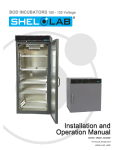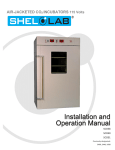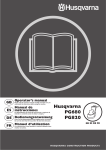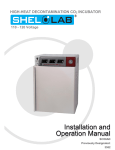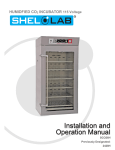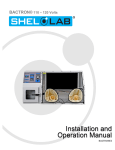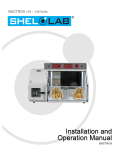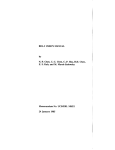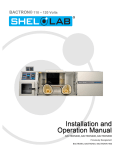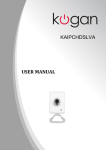Download SRI6PF SRI20PF
Transcript
FLY INCUBATORS 100 - 120 Voltage Installation and Operation Manual SRI6PF, SRI20PF Previously Designated LI6P-FLY, LI20P-FLY Sheldon Refrigerated Incubator Peltier FLY 100 - 120 Voltage Installation and Operation Manual Part Number (Manual): 4861674-1 Revision: February 6, 2015 Pictured on Cover: SRI6PF Left, SRI20PF Right These units are TÜV CUE listed as incubators and radiant warmers for professional, industrial, or educational use where the preparation or testing of materials is done at approximately atmospheric pressure and no flammable, volatile, or combustible materials are being heated. These units have been tested to the following requirements: CAN/CSA C22.2 No. 61010-1:2012 CAN/CSA C22.2 No. 61010-2-010 + R:2009 UL 61010A-2-010:2002 UL 61010-1:2012 EN 61010-1:2010 EN 61010-2-010:2003 2|Page TABLE OF CONTENTS INTRODUCTION........................................................................................................................................... 4 General Safety Considerations ................................................................................................................. 4 Engineering Improvements ....................................................................................................................... 5 Contacting Assistance ............................................................................................................................... 5 RECEIVING YOUR INCUBATOR ................................................................................................................ 6 Inspecting the Shipment ............................................................................................................................ 6 Orientation Photos..................................................................................................................................... 7 Recording Data Plate Information ............................................................................................................. 9 INSTALLATION .......................................................................................................................................... 10 Location ................................................................................................................................................... 10 Power Source .......................................................................................................................................... 10 Lifting and Handling ................................................................................................................................ 11 Leveling ................................................................................................................................................... 11 Access Port Stopper ............................................................................................................................... 11 Initial Cleaning and Deionized Water ...................................................................................................... 12 Install Side Air Ducts SRI20PF ............................................................................................................... 12 Shelving Installation ................................................................................................................................ 13 GRAPHIC SYMBOLS ................................................................................................................................. 15 CONTROL PANEL OVERVIEW ................................................................................................................. 16 OPERATION ............................................................................................................................................... 18 Theory of Operation ................................................................................................................................ 18 Prepare the Incubator ............................................................................................................................. 20 Control and Display Set Up ..................................................................................................................... 20 Set Current and Cycle Start Times ......................................................................................................... 21 Disable the OTL ...................................................................................................................................... 23 Set the Daytime Temperature Set Point ................................................................................................. 24 Set the Nighttime Temperature Set Point ............................................................................................... 25 Calibrate the Temperature Display ......................................................................................................... 26 Set the Over Temperature Limit .............................................................................................................. 31 Turn Alarm Off / On ................................................................................................................................. 32 Launching the Auto Cycle ....................................................................................................................... 34 Ending the Auto Cycle ............................................................................................................................. 34 Loading the Incubator ............................................................................................................................. 35 Attaching equipment to the Interior Accessory Outlet ............................................................................. 35 Humidifying the Incubator ....................................................................................................................... 35 Managing Condensation ......................................................................................................................... 36 USER MAINTENANCE ............................................................................................................................... 37 Cleaning and Disinfecting ....................................................................................................................... 37 Maintaining Atmospheric Integrity ........................................................................................................... 38 Electrical Components ............................................................................................................................ 38 UNIT SPECIFICATIONS............................................................................................................................. 39 Weight ..................................................................................................................................................... 39 Dimensions .............................................................................................................................................. 39 Capacity .................................................................................................................................................. 39 Shelf Capacity by Weight ........................................................................................................................ 40 Temperature ............................................................................................................................................ 40 Power ...................................................................................................................................................... 40 PARTS LIST ............................................................................................................................................... 41 3|Page INTRODUCTION Thank you for purchasing a Sheldon Refrigerated Peltier Fly Incubator. We know that in today’s competitive marketplace, customers have many choices when it comes to constant temperature equipment. We appreciate you choosing ours. Our continued reputation as a leading laboratory product manufacturer rests with your satisfaction. Sheldon Manufacturing, Inc. stands behind our products, and we will be here if you need us. These incubators are intended for professional, industrial, or educational use for fruit fly cultivation. They are not designed for use in hazardous or household locations. Before using the incubator read this entire manual carefully to understand how to install, operate, and maintain the unit in a safe manner. Keep this manual available for use by all workstation operators. Ensure that all operators are given appropriate training prior to using the incubator. Note: This unit is designed for the growth, cultivation, incubation, and storage of fruit flies (Drosophila melanogaster). Improper use of this unit will void the manufacturing defect warranty. Other units are specifically manufactured for BOD applications. Consult your Shel Lab dealer or customer service representative in order to identify another model suitable for your application. GENERAL SAFETY CONSIDERATIONS Note: Failure to follow the guidelines and instructions in this manual may create a protection impairment by disabling or interfering with the unit safety features. This can result in injury or death. Your incubator and its recommended accessories are designed and tested to meet strict safety requirements. Only use this equipment for its intended application. Any alterations or modifications void the warranty. For continued safe operation of your incubator always follow basic safety precautions including: Follow all local ordinances in your area regarding the use of this incubator. If you have any questions about local requirements, please contact the appropriate local agencies. The power supply for the unit must be an earth-grounded electrical outlet that conforms to national and local electrical codes. If the incubator is not grounded properly, parts such as knobs and controls can conduct electricity and cause serious injury. Always use the power cord supplied with the unit or an identical replacement cord. Avoid damaging the power cord. Do not bend it excessively, step on it, or place heavy objects on it. A damaged cord can be a shock or fire hazard. Never use a power cord if it is damaged. Position the unit so that the user can quickly unplug the cord in the event of an emergency. Use only approved accessories. 4|Page INTRODUCTION (CONTINUED) ENGINEERING IMPROVEMENTS Sheldon Manufacturing continually improves all of its products. As a result, engineering changes and improvements are made from time to time. Therefore, some changes, modifications, and improvements may not be covered in this manual. If your unit’s operating characteristics or appearance differs from those described in this manual, please contact your Shel Lab dealer or distributor for assistance. CONTACTING ASSISTANCE If you are unable to resolve a technical issue with your incubator, please contact Sheldon Technical Support. Phone hours for Sheldon Technical Support are 6am – 4:30pm Pacific Coast Time (west coast of the United States, UTC -8). Please have the following information ready when calling or emailing Technical Support: the model number and the serial number (see page 9). EMAIL: [email protected] PHONE: 1-800-322-4897 extension 4, or (503) 640-3000 FAX: (503) 640-1366 Sheldon Manufacturing INC. P.O. Box 627 Cornelius, OR 97113 5|Page RECEIVING YOUR INCUBATOR Before leaving the factory, all incubators are packaged in high-quality shipping materials to provide protection from transportation-related damage. When a unit leaves the factory, safe delivery becomes the responsibility of the carrier. Damage sustained during transit is not covered by the warranty. This makes it important that you inspect your incubator for concealed loss or damage to its interior and exterior when receiving it. If you find any damage to the unit, follow the carrier’s procedure for claiming damage or loss. The orientation photos found on the following pages may serves as a useful visual guide for inspections. INSPECTING THE SHIPMENT Carefully inspect the shipping carton for damage. Report any damage to the carrier service that delivered the incubator. If the carton is not damaged, open the carton and remove the contents. The unit should come with an Installation and Operation Manual, warranty card, and a Certificate of Compliance. Verify that the correct number of the following accessories are present: Model Shelves Shelf Mounts Shelf Mounts SRI6PF 2 4 Standard Brackets -- SRI20PF 5 8 Standard Brackets 2 Sliding Brackets Model Leveling Feet Access Port Stopper* Side Air Duct Panels SRI6PF 4 1 0 SRI20PF 4 1 2 A 115V 2.5 meter, NEMA 5-15P power supply cord. *The stopper should come installed in the access port, inside the unit incubation chamber. The incubator requires a temperature reference thermometer accurate to at least 0.1°C for performing temperature display calibrations. The reference sensor must be purchased separately. For best results, use a digital reference device with a wire sensor probe to take remote readings. Remote readings offer at least 1 hour of time savings during each calibration. Do not use an alcohol thermometer. Please see the Calibration procedure on page 26 of the Operation section for more information. Carefully check all packaging before discarding. Save the shipping carton until you are sure everything works properly. 6|Page RECEIVING YOUR INCUBATOR (CONTINUED) ORIENTATION PHOTOS Peltier Thermoelectric Chiller – Heater Housing SRI20PF Control Panel Door Gasket Power Inlet for Cord, Fuse, and Data Plate (Back of the Incubator) Day Phase Illumination LED Bar Drain Port – TEC-H Housing Incubation Chamber Door Temperature Sensor Probes Access Port Chamber Power Outlet Shelf Standard Rail Sliding Shelf Mount 7|Page RECEIVING YOUR INCUBATOR (CONTINUED) SRI6PF Power Inlet for Cord, Fuse, and Data Plate (Back of the Incubator) Peltier Control Panel Thermoelectric Chiller – Heater Housing Temperature Sensor Probes Drain Port – TEC-H Housing Chamber Power Outlet Day Mode LED Bar Access Port Incubation Chamber Door Door Gasket 8|Page RECEIVING (CONTINUED) RECORDING DATA PLATE INFORMATION The data plate contains the incubator model number and serial number. Record this information for future reference. The data plate is located on the back of the unit, on the top right side. Data Plate Date Plate Information Model Number Serial Number 9|Page INSTALLATION This incubator is intended for use indoors, at room temperatures between 15C and 30C (59F and 86F), at no greater than 80% Relative Humidity at 25C (77F). Allow a minimum of 4 inches (10cm) between the incubator and walls or partitions and 2 inches (5cm) of clearance above the top of the incubator for unobstructed airflow. Position the unit so the end-user has access to the power plug. Operating the unit outside of these conditions may adversely affect the temperature range and stability. For conditions outside of those listed above, please contact your distributor or Sheldon Sales to explore other incubator options suited to your laboratory or production environment. LOCATION When selecting a location to install the incubator, consider all environmental conditions that can affect the effective temperature range, uniformity, and stability of the unit. For example: Ovens, autoclaves, and any device that produces significant radiant heat Heating and cooling ducts, or other sources of fast moving air currents High-traffic areas Direct sunlight POWER SOURCE Note: The electrical supply to the incubator must conform to all national and local electrical codes. Always position the unit so that the end-user has access to the power cord in the event of an emergency. When selecting a location for an SRIPF incubator verify that the earth-grounded wall power source matches the voltage and ampere requirements listed on the incubator data plate. Supplied voltage must not vary more than 10% from the data plate rating. Damage to the incubator may result if supplied voltage varies more than 10%. Damage from a power supply that does not match the data plate requirements is not covered by the manufacturing defect warranty. Use a separate circuit to prevent loss of product due to overloading or circuit failure. These incubators are intended for a 50/60 Hz application at the following amperages: SRI6PF SRI20PF 4 Amps 5.5 Amps These units are provided with an 115V 2.5 meter, NEMA 5-15P power supply cord. 10 | P a g e INSTALLATION (CONTINUED) LIFTING AND HANDLING An SRIPF Incubator should only be lifted by its bottom surfaces using proper heavy lifting machinery such as, a forklift or pallet jack. Handles and knobs are inadequate for lifting or stabilization. The unit should be completely restrained from tipping during lifting. Transporting the unit while lifted is not recommended and may be hazardous. Remove all moving parts, such as shelves and trays, and secure the door in the closed position prior to lifting the unit. Do not attempt to move the unit while in operation or before the unit has cooled. LEVELING The SRIPF Incubator must be level and stable for safe operation. Each incubator ships with four leveling feet. Insert one leveling foot into each of the four holes in the bottom corners of the workstation. Adjust the foot at each corner until the workstation stands level and solid without rocking. To raise a foot, turn it in a counterclockwise direction; to lower a foot, turn it in a clockwise direction. To prevent damage to feet while in transport, turn all the feet to the maximum counterclockwise position. ACCESS PORT STOPPER Each SRIPF incubator is provided with an access port located back wall of the incubation chamber. The incubator is shipped with one rubber access port stopper installed in the port inside the chamber. The stopper should always be installed in the chamber side to obtain the best temperature uniformity and prevent condensation from forming inside the port. A second stopper may be installed on the outside of the unit to prevent dust from building up in the port, but is not required. Wires for thermocouples and other sensor probes may be introduced into the chamber the access port. The stopper may be put in place over the wire. Seal any gaps using a non-adhesive tape that will not leave adhesive residue when removed. The port stopper must be in place during operation for the incubation chamber to achieve its specified temperature stability and uniformity levels. 11 | P a g e INSTALLATION (CONTINUED) INITIAL CLEANING AND DEIONIZED WATER The incubator interior was cleaned at the factory but not sterilized. It may have been exposed to contaminants en route during shipping. Cleaning and disinfecting the chamber and shelving (as well as the air duct panels of the SRI20PF) prior to placing the unit in operation lowers the chance of microbiological contamination. See the Cleaning topic in the User Maintenance section (page 37) for more information on how to clean and disinfect the incubation chamber. Remove all wrappings and coverings from shelving prior to cleaning and installation. Never use deionized water for cleaning the incubator! While DI water is useful in variety of laboratory applications, it is an aggressive solvent that attacks most metals. Use of DI water voids the manufacturing defects warranty. Use of distilled water in the resistance range of 50K Ohm/cm to 1M Ohm/cm, or a conductivity range of 20.0 uS/cm to 1.0 uS/cm is recommended for cleaning and any humidifying applications. INSTALL SIDE AIR DUCTS SRI20PF Two (2) side air duct panels are included in the SRI20PF accessories. Place the hooks on the top and bottom corners of the panel into the slots provided on the shelf standard mounting rails. The SRI6PF incubator does not require side ducts. Figure 1: SRI20PF Air Duct Panel Note: The air duct panels play an important role maintaining even heat distribution inside the long incubation chamber of the SRI20PF. Failure to install both air duct panels may adversely impact the incubator’s temperature uniformity. 12 | P a g e INSTALLATION (CONTINUED) SHELVING INSTALLATION SRI6PF and SRI20PF Standard Shelving Installation Perform the following steps to install the SRI6PF and SRI20PF incubator standard shelves: Figure 2: Standard Shelf Mounting Bracket Installation 1. Insert the 2 pairs of tabs on the bracket (front and back) into the slots on the shelf standard rails of the incubator chamber. 2. Slide the bracket down so that the tabs are securely seated in the mounting slots. 3. Repeat the process on the opposite side of the chamber with the second mounting bracket. 4. Hang one shelf off the 2 installed mounting brackets. Figure 3: Standard Mounting Bracket Installed Figure 4: Standard Shelf Hung From Mounting Bracket 13 | P a g e INSTALLATION (CONTINUED) SRI6PF and SRI20PF Sliding Shelf Installation Note: The SRI6PF does not come with a sliding shelf. Sliding shelves for the SRI6PF must be purchased separately. Figure 5: Sliding Shelf Mounting Bracket Installation Figure 6: Sliding Shelf Mounting Bracket Installation 1. Insert the sliding bracket’s two pairs of tabs (front and back) into the slots on the shelf standards. See Figure 5. 2. Slide the bracket down so that the tabs are securely seated in the mounting slots. See Figure 6. 3. Secure the bottom flange of the sliding bracket to the shelf standard rails by threading and screwing in 2 screws, on the front and back of the flange. See Figures 7 and 8. 4. Repeat the process on the opposite side of the chamber with the second sliding mounting bracket. 5. Hang 1 shelf from the 2 installed sliding mounting brackets. Figure 7: Sliding Mounting Bracket Screws 14 | P a g e Figure 8: Sliding Mounting Bracket Front Screw Installed GRAPHIC SYMBOLS The incubator is provided with graphic symbols on its interior and exterior surfaces. The symbols identify hazards and the functions of the adjustable components, as well as important notes in the user manual. Symbol Definition Indicates that you should consult your service manual for further instructions. Indique que l'opérateur doit consulter le manuel d'utilisation pour y trouver les instructions complémentaires. Indicates Temperature Repère température Indicates the Over Temperature Limit system Indique le système de dépassement de temperature Indicates AC Power Repère le courant alternatif Indicates I/ON and O/OFF I repère de la position MARCHE de l'interrupteur d'alimentation O repère de la position ARRÊT de l'interrupteur d'alimentation Indicates protective earth ground Repère terre électrique Indicates UP and DOWN respectively Touches de déplacements respectifs vers le HAUT et le BA Indicates Manually Adjustable Indique un bouton réglable manuellement Indicates Potential Shock Hazard Signale danger électrique WEEE Directive compliant logo Indicates the unit should be recycled (Not disposed of in land-fill) Indique l’appareil doit être recyclé (Ne pas jeter dans une décharge) 15 | P a g e CONTROL PANEL OVERVIEW Figure 9: SRI6PF and SRI20PF Control Panel Power Switch The green power switch on the panel controls all power to the unit and its systems. The switch illuminates when in the On position ( I ). Time Display The green LED display labeled TIME on the left side of the panel operates as a 24-hour clock (00:00 – 23:59). During normal operations it displays the current time. When setting the start times of the automatic day – night illumination and temperature cycle it shows the Daytime start time and the Nighttime start time separately. Three LED lights immediately below the Time screen indicate the present mode of display: Current Time, adjustable Daytime start time, and the adjustable Nighttime start time. Temperature Display Marked SET TEMPTERATURE, this digital display shows the air temperature in the incubation chamber, accurate to 0.1°C. The display can also show the adjustable temperature set points of the Day and Night modes, as well as display value adjustments during temperature calibrations. Just below the Temperature Display are two LED lights, Day Temp and Night Temp. These indicate which mode the incubator is running in (Day or Night), as well as which mode’s temperature set point is being displayed when adjusting the set points. Temperature and Timer Control Arrows Temperature functions: The arrow buttons are used to adjust the temperature set points of the Day and Night modes. When the display is in its temperature calibration menu, the arrow keys are used to make calibration adjustments. Time functions: When the time display is in the Time Set Up menu, the arrow buttons adjust the Current Time, then the auto cycle Daytime and Nighttime start times. 16 | P a g e CONTROL PANEL (CONTINUED) Enter Button The ENTER button is used in the Time Set Up menu to save adjustments to the Current Time, as well as the auto cycle Day and Night start times. The Enter button can also be used to scroll forward through the menu. Mode Button Pressing and immediately releasing the button enters the Time Setup menu. Pressing and holding the Mode button for 5 seconds switches the incubator between the Daytime and Nighttime modes when the day – night auto cycle is not running. Cycle Start Button Pressing and holding this button for 2 seconds will launch the day – night auto cycle, or terminate the cycle if it is running. The green PROGRAM ACTIVE indicator to the right of the button illuminates when the auto cycle is running. Heating and Cooling Light The green pilot light located beneath the label TEC ACTIVATED illuminates whenever the Peltier TEC-H device is chilling or heating the chamber. The light will be on almost continually during normal operations as the unit makes continual, small temperature compensations. Set Over Temperature This control is equipped with a graduated dial. The OTL is a mechanical heating cut off system that operates independently of the digital temperature controller. It guards against failures of the digital controller that would allow the chamber temperature to rise past the controller set point. Please see the Over Temperature Limit System description in the Theory of Operations section (page 19) for a more complete explanation. OTL Light The red pilot light marked OVER TEMPERATURE ACTIVATED illuminates when the Over Temperature Limit system cuts power to the Peltier TEC heating circuits. Under normal operating conditions this indicator should never turn on. Fuse Located on the top back of the unit inside the cord inlet, the fuse protects against over current conditions. If the fuse blows, the unit will shut down. The cause of a blown fuse should be determined prior to replacing it. 17 | P a g e OPERATION THEORY OF OPERATION The SRIPF family of fly incubators is designed to provide a variable temperature and illumination environment suitable for the cultivation and storage of fruit flies (Drosophila melanogaster). The incubator runs in one of two modes, Daytime and Nighttime. In its Daytime mode the incubator provides continual illumination in the incubation chamber using two side mounted, white light LED bars. In Night mode the chamber is left dark, though a small LED bar at the top of the chamber will illuminate whenever the chamber door is opened. The Day and Night modes have independent, programmable temperature set points. Both are set to 20°C at the factory, but can be adjusted to different temperatures in order provide a thermal variation between the modes. The SRIPF incubator comes from the factory set to run indefinitely in the Daytime mode. Users can manually switch between it and the nighttime mode by pressing and holding the MODE button. The incubator is also provided with a Day – Night Auto Cycle, which when launched will cycle the between the two modes until manually terminated. As set at the factory, the cycle transitions between modes are 12 hours apart. These start time points can be adjusted using the incubator controls. During Day mode operations the incubator digital controller automatically compensates for a small amount of extra heat generated by the active LED light bars in the incubation chamber. Heating and Cooling Conventional low-temperature capable incubators rely on a competition between a refrigeration compressor and a resistive heating element to achieve stable chamber temperatures. SRIPF incubators employ an alternative, power saving thermoelectric cooling-and-heating device. The TEC-H operates using the Peltier effect, in which the junctures between two electrified conductive plates generate a gradient of temperature differences. In other words, a current between the conductors produces a flow of heat away from one plate to the other. The direction of this gradient can be flipped by reversing the direction of the current. The sandwiched TEC conductors effectively operate as a reversible heat pump that is significantly more efficient than a compressor – element pairing. This power-use efficiency results in far less waste heat and a corresponding reduction in cooling demand placed on laboratory air conditioning systems. Heating and cooling of the incubation chamber is controlled by the incubator digital microprocessor controller. The controller stores the Daytime mode and Nighttime mode temperature set points. The controller monitors the air temperature of the incubation chamber using a solid state sensor probe located in the chamber airstream. When an air temperature deviation from the active set point is detected, the controller pulses power to the TEC-H device to add or remove heat from the chamber. Heated or chilled air is circulated through the chamber using a fan attached to the TECH. 18 | P a g e OPERATION (CONTINUED) The controller employs proportional-integral-derivative (PID) analytical feedback-loop functions when measuring and controlling the chamber temperature. The intensity of PID-controlled heating or chilling is proportional to the difference between the measured chamber temperature and the current temperature set point. The frequency of heating or chilling pulses is derived from the rate of change in the difference. Integrator feedback slows the rate of heating or chilling as the chamber temperature approaches the set point, which helps prevent overshoots. During normal operations, with the chamber door closed, the Peltier device pulses heat or cold to the chamber almost continuously, as indicated the green TEC Activated pilot light. These are short, low-power pulses to compensate for deviations of a hundredth degree Celsius (±0.01°C). As a solid state device, the Peltier TEC-H also offers significant maintenance savings cost. The device can be replaced by a service technician using a screwdriver and a nut driver. It does not require a certified refrigeration specialist with refrigeration tools, replacement coolant fluid, and does not contain a system of fragile, pressurized fluid vessels. Door Alarm The SRIPF incubator is equipped with a magnetic induction door alarm, which activates when the door is opened and its two sensor components are moved out of range of one another for 60 seconds. When the alarm is active an audio alert will sound and the control panel display will flash. Leaving the door open for extended periods disrupts the temperature uniformity and stability of the incubation chamber, and may result in significantly increased power use as the controller attempts to compensate for the disruption. The alarm may be turned off using the Arrow buttons. Please see the Turn Alarm Off / On procedure on page 32. Accessory Compatibility Make sure that any accessory equipment you will be using inside an SRIPF incubator can safely operate within your selected temperature range. Powered accessories such as, stirrers or shakers that produce significant waste heat may interfere with the temperature uniformity and operating range of the chamber. Additionally, fruit flies can produce aerosolized acidic metabolic byproducts that may affect the long-term performance of accessory equipment. The Over Temperature Limit System OTL system is a mechanical heating cut off system provided with its own temperature sensor probe in the incubation camber. When set, the OTL system prevents runaway heating in the event of a failure of the microprocessor controller or its thermometer probe while the TEC-H is heating the chamber. The OTL does this by depowering the TEC-H heating circuits whenever the temperature in the incubation chamber exceeds the OTL setting. Typically the OTL is set 1°C above the digital controller temperature set point. Because of its nature as a mechanical system and its lack of PID analytics, the OTL cannot deliver the same degree of temperature stability and measurement precision as the digital controller. The OTL System should only be used as a means of heating regulation for the incubation chamber until a failed controller or its thermometer probe can be repaired or replaced. The OTL will not prevent a rise in heat caused by a complete failure of the Pletier TEC-H itself. With the loss of the chilling function the chamber temperature will rise to the ambient room temperature plus 1 or 2°C. 19 | P a g e OPERATION (CONTINUED) Note: Setting up the incubator for use in a new workspace environment requires an 8-period for the unit to come up to temperature and sit undisturbed. This is done to achieve thermal stability. Thermal stabilization at the operational set point is necessary to achieve an accurate on-site temperature calibration. See the Calibrating the Temperature Display procedure on page 26 for more information. PREPARE THE INCUBATOR Perform the following steps to prepare the incubator for use each time it is installed in a new location: 1. If you have not done so, clean and disinfect the incubation chamber, if required by your laboratory protocol. Please see page 12 in the Installation section. 2. You may place a temperature reference device or its sensor probe inside the incubation chamber at this time. a. Placing a probe in the chamber now for taking remote readings saves significant time during the Temperature Calibration procedure. See page 26 for probe placement instructions. 3. Verify that the access port stopper is in place inside the incubation chamber. a. The stopper can be carefully sealed over the wire of a temperature probe. 4. If you have not done so, verify that the workspace power supply and incubator data plate requirements match. Please see page 10 in the Installation section. 5. Plug the power cord into the earth-grounded electrical outlet. 6. Place the Power switch in the ON ( I ) position. CONTROL AND DISPLAY SET UP At initial power up the incubator will run in its Day mode. Do not launch the auto cycle or manually switch to the Night mode until a temperature calibration has been performed. The incubator comes from the factory set to run at 20˚C in both the Daytime and Nighttime modes. Perform the following procedures to adjust the incubator time and temperature parameters to those of your laboratory protocol, as well as to calibrate the incubator in the new workspace environment: 1. Set the Current and Cycle Start Times page 21 2. Disable the OTL page 23 3. Set the Day Mode Temperature Set Point page 24 4. Set the Night Mode Temperature Set Point page 25 5. Calibrate the Temperature Display page 26 6. Set the Over Temperature Limit Control page 31 20 | P a g e OPERATION (CONTINUED) SET CURRENT AND CYCLE START TIMES Enter the Time Set Up menu to set the display clock to your current local time. Adjust the auto cycle Daytime and Nighttime start times if needed. The incubator comes from the factory set to US Pacific Time. The auto cycle day start is factory set to 08:00 (8am), and the night start is 20:00 (8pm). 1. Press and release the Mode button to enter the Time Set Up menu. Factory Current Time a. The Current LED will stay lit. b. The Temperature display will turn off. c. The Time display will show a blinking, adjustable time setting. 2. Adjust the Current time to match your local time using the UP and DOWN arrows. Adjusted Time a. 24-hour clock afternoon and evening times are 12 hours greater than the 12-hour clock PM equivalents. Example: 1 PM = 13:00; 6 PM = 18:00; 9 PM = 21:00. 12 AM = 00:00. Pressing Enter without adjusting the display will skip to setting the Daytime start time. 3. Save the adjusted Current time. Adjusted Time Saved a. Press and release the Enter button. b. This saves the flashing time shown in the display as the new Current time. 4. The display will automatically advance to the auto cycle Daytime Start Time. Cycle Day Start: Factory Setting a. The Temperature Display will remain dark. b. Time Display will continue to flash, but now displays the adjustable Daytime start time. c. The Current Time indicator LED will extinguish. d. The Daytime LED indicator illuminates. Procedure continued on next page 21 | P a g e OPERATION (CONTINUED) Set Times (Continued) 5. Use the UP and DOWN arrow keys to adjust the cycle Daytime Start Time. Adjusted Day Start Pressing Enter without adjusting the display will save the unadjusted Day Start Time and skip to setting the Nighttime start time. Adjusted Time Saved 6. Save the adjusted cycle Day Start time. a. Press the Enter button after adjusting the Day Start Time. 7. The display will automatically advance to the auto cycle Nighttime Start Time. a. The Temperature Display will remain dark. b. The Daytime indicator LED will extinguish. c. Night Time indicator will illuminate. d. The flashing Time Display will now show the adjustable Nighttime Start Time. 8. Use the UP and DOWN arrow keys to adjust the Nighttime Start Time. Cycle Night Start: Factory Setting Adjusted Night Start a. 24-hour clock afternoon and evening times are 12 hours greater than the 12-hour clock PM equivalents. Example: 1 PM = 13:00; 6 PM = 18:00; 9 PM = 21:00. 12 AM = 00:00. Pressing Enter without adjusting the display will save the unadjusted Night Start Time and exit the Time Set up menu. 9. Save the adjusted cycle Night Start Time. a. Press Enter after adjusting the Night Start Time. 10. The display will exit the Time Set Up menu and resume showing the Current time. a. The Time Display will cease blinking. b. The Temperature Display will turn on. c. The Nighttime LED will extinguish. d. The Current time LED will illuminate. End of procedure 22 | P a g e Adjusted Time Saved Returned to Current Time Display OPERATION (CONTINUED) Note: The OTL should ship from the factory set to the maximum position. DISABLE THE OTL Set the OTL dial to its maximum position. This prevents the OTL system from interfering with raising the temperature set point or the conducting the temperature display calibration procedure. 1. Turn the Over Temperature Limit control dial clockwise to the maximum position indicated by the largest dot. 2. Leave the control at its maximum position until the Set Temperature and / or Calibrate Temperature Display procedures have been completed. 3. See page 31 for instructions on how to set the OTL after the above procedures are completed. 23 | P a g e OPERATION (CONTINUED) SET THE DAYTIME TEMPERATURE SET POINT Perform the following steps to adjust the temperature set point of the Daytime Mode to that of your laboratory or study protocol. The incubator comes from the factory with a Day set point of 20°C. Skip this procedure if your protocol requires the incubator to be run at 20°C under day conditions (with the chamber illumination on continually). Matching the set point to your protocol also prepares the unit for temperature calibration. If the auto cycle is active and you will be performing a temperature calibration after adjusting the set points, terminate the cycle. The unit must be run in Daytime mode to adjust the Day temperature. 1. Verify that the incubator is running in Daytime mode. Advance to step 2 if it is. – Or – a. If the auto cycle is running in Nighttime mode, terminate the cycle and manually place the unit in Daytime mode. Press and hold the Cycle Start button for two seconds. The Program Active Light will extinguish. b. To switch from Nighttime to Day, press and hold the Mode button for 5 second. The blue Night Temp indicator will extinguish, the Day Temp will illuminate. 2. Place the Temperature display into the Daytime Set Point mode. a. Press and release the Up or the Down arrow button. b. The Time display will go dark. c. The Temperature display will briefly flash the letters “SP”. d. The Temperature display will show the blinking, adjustable Day Temp set point. Program Active Light Off Daytime Mode Set Point 3. Use the UP and DOWN arrow keys to adjust the blinking set point. If neither key is pressed within 5 seconds the display will exit the set point adjustment, and resume showing the current chamber temperature. The last displayed set point will now be saved as the new Daytime Mode temperature set point. 4. After the desired temperature set point is selected, release the control. a. The Temperature display will cease flashing. b. The display will revert to showing the current chamber air temperature. c. The adjusted set point is now saved. d. The incubator will begin cooling or heating to achieve the new Daytime set point. End of procedure 24 | P a g e Adjusted Day Set Point Chamber Heating to Achieve the New Set Point OPERATION (CONTINUED) SET THE NIGHTTIME TEMPERATURE SET POINT Perform the steps below to adjust the temperature set point of the Nighttime mode to that of your laboratory or study protocol. The incubator comes from the factory with a Night set point of 20°C. Skip this procedure if your protocol requires the incubator to be run at 20°C under night conditions (with the chamber dark). Matching the set point to your protocol also prepares the unit for temperature calibration. If the auto cycle is active and you will be performing a temperature calibration after adjusting the set points, terminate the cycle. The unit must be run in Nighttime mode to adjust the Night temperature. 1. Verify that the incubator is running in Nighttime mode. Advance to step 2 if it is. – Or – a. If the auto cycle is running in Daytime mode, terminate the cycle and manually place the unit in Nighttime mode. Press and hold the Cycle Start button for two seconds. The Program Active Light will extinguish. b. To switch from Daytime to Night, press and hold the Mode button for 5 second. The Day Temp indicator will extinguish, the blue Night Temp will illuminate. 2. Place the Temperature display into the Nighttime Set Point mode. a. Press and release the Up or the Down arrow button. b. The Time display will go dark. c. The Temperature display will briefly flash the letters “SP”. d. The display will show the blinking, adjustable Night Temp set point. Program Active Light Off Nighttime Mode Set Point 3. Use the UP and DOWN arrow keys to adjust the blinking set point. Adjusted Night Set Point If neither key is pressed within 5 seconds the display will exit the set point adjustment and resume showing the current chamber temperature. The last displayed set point will now be saved as the new Nighttime mode temperature set point. 4. After the desired temperature set point is selected, release the control. a. The Temperature display will cease flashing. b. The Time display will illuminate. c. The Temperature display will revert to showing the Current chamber air temperature. d. The adjusted set point is now saved. e. The incubator will begin cooling or heating to achieve the new Nighttime set point. Chamber Cooling to Achieve the New Set Point End of procedure 25 | P a g e OPERATION (CONTINUED) CALIBRATE THE TEMPERATURE DISPLAY Temperature calibrations are performed to ensure that the temperature display matches the actual air temperature inside the incubation chamber. Calibrate as often as required by your laboratory protocol or regulatory compliance. A temperature calibration should be performed after changing the operating temperature set point or installing the incubator in a new workspace, as ambient conditions may affect unit performance. Allow the incubator to run at its Daytime Mode set point temperature undisturbed with no door openings for 8 hours prior to this procedure. This allows the chamber to stabilize with no fluctuations of ±0.1°C or greater. Failure to allow at least 8 hours will result in an inaccurate temperature calibration. The Day and Night Mode temperature set points require separate calibrations, even if both are set to the same temperature. This is due to heat generated by the day illumination LED light bars when the Day mode is active. This procedure requires a temperature reference sensor device. Always use a reference device calibrated to at least 0.1°C. For best results use a digital device with a wire sensor probe to take remote readings without disturbing the chamber temperature. Do not use an alcohol thermometer. Part 1: Calibrate the Daytime Temperature Daytime Temp 1. If you have not already done so, place the temperature sensor of the reference device inside the incubator as close as possible to the chamber geometric center. Check that the sensor is not in direct contact with the shelving. Note: A thermocouple sensor probe’s sleeve may be taped to the shelving, as long as the exposed copper end is 2 inches (5cm) above the shelf. An exposed sensor probe in direct contact with the shelving may experience heat sinking, which can result in an inaccurate temperature reading. 2. The incubator should already be running in Day Mode with the auto cycle turned off during the calibration. a. Turn off the auto cycle if it is running by pressing and holding the Start Cycle button for 2 seconds. b. If not already in the Daytime Mode place the incubator in Day Mode with the Day Time Temperature indicator LED illuminated. Procedure continued on next page 26 | P a g e Note: Sensor probes may be introduced into the chamber through the door, or the access port. Place the stopper back into the port over the wire after introducing a probe. The stopper must be in place to perform an accurate calibration. Day Mode Program Active Light Off OPERATION (CONTINUED) Daytime Temperature Calibration (Continued) 3. Allow the temperature to re-stabilize if the door or access port have been opened after the 8-hour stabilization, or if the unit was placed in Nighttime mode during or after the stabilization period. a. The reference device temperature measurement should not change for at least 1 hour in order for the chamber to be considered re-stabilized. 4. Once the temperature has stabilized, compare the reference device and the incubator display temperature readings. If the readings are the same, or the difference between the two falls within the acceptable range of your laboratory protocol, the incubator is calibrated for Day Mode temperature. Advance to the Night Calibration steps on page 29. 1 Hour Minimum Reference Device 5. If there is a difference between the two readings, and that offset falls outside your laboratory protocol acceptable range, place the incubator into calibration mode. See the next step. Reference Device a. Before placing the unit in calibration mode, allow the temperature to re-stabilize if the door has been opened. This will require a wait of at least one 1 hour. Failure to do so will result in an inaccurate calibration. 6. Place the unit in its temperature calibration mode and calibrate. a. Press and hold both the UP and DOWN arrow buttons simultaneously. Calibration Mode b. The Temperature Display will show the letters “CO”, then begin flashing the current display temperature value. c. Use the Up or Down arrows to adjust the temperature display value until it matches the reference device temperature reading. This will correct the display error. Corrected Display d. If an arrow key is not pressed for five seconds, the Temperature Display will cease flashing, and store the last displayed value as the new current chamber temperature value. Procedure continued on next page 27 | P a g e OPERATION (CONTINUED) Daytime Temperature Calibration (Continued) 7. After correcting for the offset, wait five (5) seconds. a. The Temperature Display will cease flashing and store the correction. Cooling b. The display will revert to showing the Current temperature. c. The incubator will now begin heating or cooling in order to reach Day set point with the corrected display value. 8. Allow the incubator sit for one 1 hour undisturbed to stabilize after it has achieved the set point with the corrected display. Failure to wait until the unit is fully stabilized will result in an inaccurate reading. 9. Compare the reference device reading with the incubator temperature display. a. If the reference device and the incubator temperature display readings are the same or the difference falls within the range of your laboratory protocol, the incubator is now calibrated for temperature. Stablized 10. If the two readings are not the same or fall outside your laboratory protocol, repeat steps 6 – 9. 11. If the difference between the Day Mode temperature incubator readings and the reference device still fall outside your laboratory protocol after three calibration attempts, contact Technical Support for assistance. a. Three calibration attempts may be required to successfully calibrate units that are more than ±2°C out of calibration. Procedure continued on next page 28 | P a g e OPERATION (CONTINUED) Part 2: Calibrate the Nighttime Temperature Nighttime Temperature Calibration 1. Place the incubator into the Night Mode. a. Press and hold the Mode button for five seconds. b. The Day Temp indicator will extinguish. c. The blue Night Temp indicator will illuminate. 2. Wait 1 hour to allow the temperature to stabilize after the Temperature display achieves the Nighttime set point. a. The reference device temperature measurement should not change for at least one 1 hour in order for the chamber to be considered stabilized. Reference Device 3. Once the temperature has stabilized, compare the reference device and the incubator display temperature readings. If the readings are the same, or the difference between the two falls within the acceptable range of your laboratory protocol, the incubator is calibrated for Night Mode temperature. The Temperature Calibration procedure is complete. 4. If there is a difference between the two readings, and that offset falls outside your laboratory protocol acceptable range, place the incubator into calibration mode. See the next step. a. Before placing the unit in calibration mode, allow the temperature to re-stabilize if the door has been opened. This will require a wait of at least one 1 hour. Failure to do so will result in an inaccurate calibration. Reference Device Procedure continued on next page 29 | P a g e OPERATION (CONTINUED) Nighttime Temperature Calibration (Continued) 5. Place the unit in its temperature calibration mode and calibrate. a. Press and hold both the UP and DOWN arrow buttons simultaneously. Calibration Mode b. The Temperature Display will show the letters “CO”, then begin flashing the current display temperature value. c. Use the Up or Down arrows to adjust the display temperature value until it matches the reference device temperature reading. This will correct the display error. Corrected Display d. If an arrow key is not pressed for five seconds, the Temperature Display will cease flashing, and store the last displayed value as the new current chamber temperature value. 6. After correcting for the offset, wait 5 seconds. a. The Temperature display will cease flashing and store the correction. b. The incubator will now begin heating or cooling in order to reach the Night set point with the corrected display value. Cooling Stablized 7. Allow the incubator sit for 1 hour undisturbed to stabilize after it has achieved the set point with the corrected display. Failure to wait until the unit is fully stabilized will result in an inaccurate reading. 8. Compare the reference device reading with the incubator temperature display. a. If the reference device and the incubator temperature display readings are the same or the difference falls within the range of your laboratory protocol, the incubator is now calibrated for temperature. 9. If the two readings are not the same or fall outside your laboratory protocol, repeat steps 5 – 8. 10. If the Night Mode temperature readings of the incubator and the reference device still fall outside your laboratory protocol after three calibration attempts, contact Sheldon Technical Support for assistance. a. Three calibration attempts may be required to successfully calibrate units that are more than ±2°C out of calibration. End of procedure 30 | P a g e OPERATION (CONTINUED) SET THE OVER TEMPERATURE LIMIT The incubator temperature must be stable and running at its highest set point for at least 1 hour prior to setting the Over Temperature Limit. If the Day Mode will be running warmer than the Night Mode set the OTL when the Day Mode is active and at its full temperature. Perform the following steps to set up the Over Temperature Limit system for normal use: 1. If you have not done so already, turn the Set Over Temperature Limit control dial clockwise to the maximum position. This allows the Set Temperature control to stabilize. 2. Turn the Over Temperature Limit control dial counterclockwise until the red Over Temp Limit Activated light illuminates. 3. Slowly turn the Over Temperature Limit control dial clockwise until the Over Temp Limit Activated light turns off. Stop turning the control. 4. Leave the OTL control slightly above the activation point. This sets the Over Temperature Limit set to approximately 1˚C above the current temperature set point. End of procedure 31 | P a g e OPERATION (CONTINUED) TURN ALARM OFF / ON Perform the following steps to turn the door alarm off or on. Note that once set to off the alarm will not activate until the user has turned it back on. This procedure is applicable to units manufactured after January 15, 2015, or older units retrofitted with a new door alarm control chip. Turn the Door Alarm Off OFF 1. Place the temperature display in the adjustable set point menu for either the Daytime or Nighttime mode. Set Point Indicator a. Press and release either the Up or the Down arrow key while in either mode. b. The temperature display will briefly flash the letters “SP”. c. Current Set Point The display will then show an adjustable, flashing temperature set point. Door Alarm Off 2. Press and hold the Up arrow until the temperature display reads “dO”. a. “dO” indicates that “door alarm off” is selected. 3. Release the Up arrow. a. “dO” will flash approximatly six times. b. The display will then revert to showing the current chamber temperature. c. The door open alarm is now set to off, and the temperature set point has not been changed. Procedure continued on next page 32 | P a g e Current Temperature OPERATION (CONTINUED) Turn the Door Alarm On ON 1. Place the temperature display in the adjustable set point menu for either the Daytime or Nighttime mode. 1a Set Point Indicator a. Press and release either the Up or the Down arrow key while in either mode. b. The screen will briefly flash the letters “SP”. c. The display will then show an adjustable, flashing temperature set point. 2. Press and hold the Up arrow until the temperature display reads “dI”. a. 1c Current Set Point Door Alarm On “dI” indicates that “door alarm on” is selected. 3. Release the up arrow. a. “dI” will flash approximatly six times. Current Temperature b. The display will then revert to showing the current chamber temperature. c. The door alarm is now set to on, and the temperature set point has not been changed. End of procedure 33 | P a g e OPERATION (CONTINUED) Note: In the event of a power outage, the unit will restart in the last mode it was operating in. The incubator current time will automatically adjust to compensate. If active at the time of the outage, the auto cycle will continue running and automatically advance to the Day or Night mode, synched with the updated current time. LAUNCHING THE AUTO CYCLE To start the day – night Auto Cycle carry out the following step: 1. Press and hold the Cycle Start button for two seconds. 2. The Program Active LED indicator next to the Cycle Start button will illuminate. 3. The auto cycle will now run indefinitely, switching between Day and Night modes until manually terminated. ENDING THE AUTO CYCLE To terminate the Auto Cycle perform the following step: 1. Push and hold the Cycle Start button for two seconds. 2. The Program Active indicator next to the Cycle Start button will extinguish. 34 | P a g e OPERATION (CONTINUED) LOADING THE INCUBATOR Place items on the shelves inside the incubator chamber as evenly spaced as possible. Good spacing allows for maximum air circulation and a high degree of temperature uniformity. ATTACHING EQUIPMENT TO THE INTERIOR ACCESSORY OUTLET The incubator has a 1A (maximum) accessory outlet located inside the chamber. The power switch on the front panel controls power to the accessory outlet. This outlet can power equipment such as magnetic stirrers, rockers, etc. Do not attach any equipment drawing more than 1A to this outlet. Accessory equipment may produce additional heat. This heat could affect the temperature range and uniformity of this incubator. Verify that the incubator operates within your protocol’s required temperature range when the accessory equipment is installed and operating. HUMIDIFYING THE INCUBATOR Placing only a small number of open or breathable media containers in the incubator chamber may lead to excessive drying of sample media. Unusually dry environmental conditions may also contribute to sample drying. To counteract this, Sheldon Manufacturing offers an optional humidity collection pan and tubing accessory kit: Part Number 9900708. The kit redirects moisture that normally condenses on the heat sink fins of the Peltier TEC-H heating and cooling device, and uses it to humidify the incubator. After ordering and receiving the kit, place the stainless steel pan on the lowest chamber surface. Connect the tubing that comes with the kit to the port on the back of the Peltier duct cover. Run the tubing down the back of the incubator behind the shelves, and secure the end of the tubing inside the pan. The pan is supplied with a copper slug to help prevent microbial contamination. The humidification kit is intended for use while running small loads. 35 | P a g e OPERATION (CONTINUED) MANAGING CONDENSATION Excessive condensation in the incubation chamber may create leaks around the chamber door, and may cause corrosion damage if allowed to continue for significant lengths of time Condensation appears wherever the humidity level in the incubator chamber reaches the dew point. The dew point is the level of humidity at which the air cannot hold more water vapor. The warmer the air, the more water vapor it can hold. Evaporating sample media can be a source of chamber humidity. As the level of humidity rises in an incubation chamber, condensation will first appear on surfaces that are cooler than the air temperature. Near the dew point, condensation will form on any item or exposed surface that is even slightly cooler than the air. When the dew point is reached, condensation forms on nearly all exposed surfaces. Managing condensation primarily depends on either lowering the humidity level or increasing the air temperature in the incubator chamber. Note: Rising or falling air pressure from weather will adjust the dew point up and down in small increments. If the relative humidity in the incubation chamber is already near the dew point, barometric fluctuations may push it across the dew point threshold. Note: Thin air at higher altitudes holds less humidity than the denser air found at or near sea level. If condensation is forming in the incubation chamber, check the following: Is the chamber door closing and latching properly? Is the door gasket leaking? Check the gasket for damage, wear, or signs of brittleness or dryness. Replace the gasket if needed. Are frequent or lengthy chamber door openings causing significant temperature disruptions and chilling the chamber surfaces? If so, reduce the number of openings. Is the incubator exposed to an external flow of cold air such as, an air-conditioning vent or a door to a cooler hallway or adjacent room? Block or divert the air, or move the incubator. Does the ambient humidity in the room exceed the stated operating range of 80% relative environmental humidity? If so, lower the room’s humidity. Empty the humidity collection pan frequently. Make sure items on the shelves are evenly spaced to allow for good airflow. Wipe down and dry condensation whenever present in the chamber. 36 | P a g e USER MAINTENANCE Warning: Prior to any maintenance or service on this unit, disconnect the power cord from the power supply. Avertissement: Avant d'effectuer toute maintenance ou entretien de cet appareil, débrancher le cordon secteur de la source d'alimentation. If a hazardous material or substance has spilled in the incubator, immediately initiate your site Hazardous Material Spill Containment protocol. Contact your local Site Safety Officer and follow instructions per the site policy and procedures. CLEANING AND DISINFECTING Note: Do not use spray cleaners or disinfectants that might leak through openings and cracks and coat electrical components, or that contain solvents that will harm coatings. Do not use chlorine-based bleaches or abrasives; these will damage the mill finish aluminum chamber liner. Warning: Never clean the unit with alcohol or flammable cleaners. Avertissement: Ne jamais nettoyer l'appareil à l'alcool ou avec des nettoyants inflammables. The incubator chamber should be cleaned and disinfected prior to first use. Periodic cleaning and disinfection are required to prevent microbiological contamination. Cleaning Perform the below steps to clean the incubator: 1. Remove all of the interior parts (shelves, racks, and any additional items), if assembled. 2. Clean the incubator with a mild soap and water solution, including all corners. Do not use deionized water. 3. Rinse with distilled water and wipe dry with a soft cloth. 4. Take special care when cleaning around the door switch, temperature sensor heads, and chamber power outlets to prevent damage. 5. Towel dry or allow the chamber to air dry before disinfecting or returning to use. Procedure continued on next page 37 | P a g e MAINTENANCE (CONTINUED) Disinfecting Disinfect the incubator on a regular basis. Perform the following steps to disinfect the workstation: 1. Turn the unit off. Carryout your laboratory, clinical, or production space disinfection protocol. 2. If possible, remove all interior accessories (shelving and other non-attached items) from the chamber when disinfecting. Disinfect all corners, the incubation chamber. Take special care when disinfecting around the temperature probes. 3. Disinfect the incubator using commercially available disinfectants that are non-corrosive, non-abrasive, and suitable for use on painted steel and mill finish aluminum surfaces. Contact your local Site Safety Officer for detailed information on the disinfectants compatible with your cultivation or culturing applications. 4. Do not use overtly volatile disinfecting agents. Chlorines, amphyls, and quaternary ammonias will evaporate into the chamber environment. Over time the concentration in the chamber atmosphere will continue to increase, potentially leading to inhibited growth or metabolic symptoms in sample populations. End of procedure MAINTAINING ATMOSPHERIC INTEGRITY Periodically, inspect the door latch, trim, catch, and gasket for signs of deterioration. Failure to maintain the integrity of the door system shortens the life span of the incubator. ELECTRICAL COMPONENTS Electrical components do not require maintenance. If the incubator fails to operate as specified, please contact your Shel Lab Dealer or Sheldon Technical Support for assistance (please see page 5). 38 | P a g e UNIT SPECIFICATIONS These incubators are 100 - 120 voltage units. Please refer to the incubator data plate to verify its electrical specifications. Technical data specified applies to units with standard equipment at an ambient temperature of 25°C and a voltage fluctuation of ±10%. The temperatures specified are determined in accordance to factory standard following DIN 12880 respecting the recommended wall clearances of 10% of the height, width, and depth of the inner chamber. All indications are average values, typical for units produced in the series. We reserve the right to alter technical specifications at all times. WEIGHT Model Shipping Net Weight SRI6PF 245lbs / 111.1kg 125lbs / 56.7kg SRI20PF 405lbs / 183.7kg 246lbs / 111.6kg Model Exterior W × D × H Interior W × D × H SRI6PF 30 x 31.5 x 33.5 in 25.5 x 24.0 x 18.5 in. SRI20PF 30 x 31.5 x 69.5 in 25.5 x 24.0 x 54.5 in. Model Exterior W × D × H Interior W × D × H SRI6PF 76.2 x 80.01 x 85.09 cm 64.8 x 61.0 x 47.1 cm SRI20PF 76.20 x 80.01 x 176.53 cm 64.77 x 60.96 x 138.43 cm Model Cubic Feet Liter SRI6PF 6.55 185.53 SRI20PF 19.30 546.57 DIMENSIONS In inches In Centimeters CAPACITY 39 | P a g e UNIT SPECIFICATIONS (CONTINUED) SHELF CAPACITY BY WEIGHT Model Per Shelf Total SRI6PF 75lbs / 34kg 150lbs / 34kg SRI20PF 75lbs / 34kg 375lbs / 170kg TEMPERATURE Model Temp Range Uniformity Stability SRI6PF 15 to 40C ±0.5 @ 20C ±0.1C @ 20C SRI20PF 15 to 40C ±0.5 @ 20C ±0.1C @ 20C Model Voltage Amperage Frequency SRI6PF 100 – 120VAC 4.0 Amps 50/60 Hz SRI20PF 100 – 120VAC 5.5 Amps 50/60 Hz POWER 40 | P a g e PARTS LIST Description Part Number Access Port Stopper 7750517 Feet, Adjustable Glide 2700506 Fuse 6.3A 3300515 Gasket, Magnetic Door SRI6PF (29 inches X 26 inches) 3450743 Gasket, Magnetic Door SRI20PF (29 inches X 62 inches) 3450732 Humidity Reservoir Pan and Tubing (Optional Accessory) 9900708 Power Cord, USA 1800510 Shelf 6800525 Static Shelf Mount (1 Bracket) 5220942 Sliding Shelf Mounting Kit (2 Brackets) 9490560 If you have the Part Number for an item, you may order the item directly from Sheldon Manufacturing by calling (503) 646-3000 Ext. 3. If you are uncertain that you have the correct Part Number or if you need that specific part, please contact Sheldon Technical Support for help at 1-800-322-4897 or (503) 6403000 extension 4. Please have the model number and serial number of the unit ready, as Tech Support will need this information to match your unit with its correct part. 41 | P a g e










































